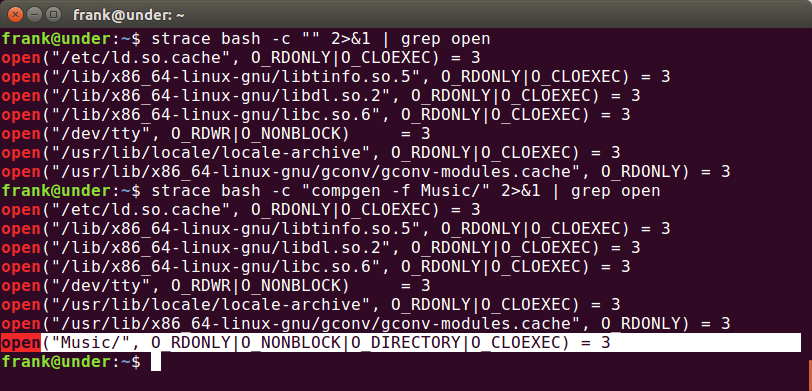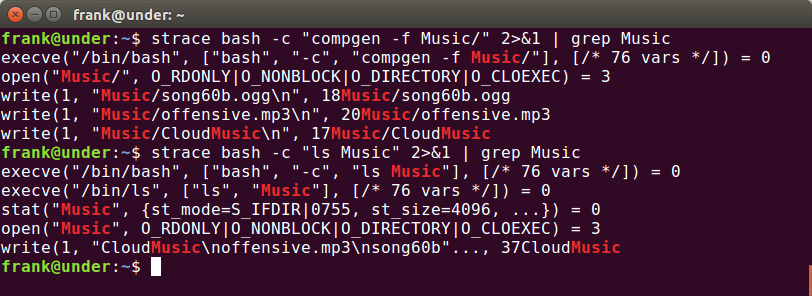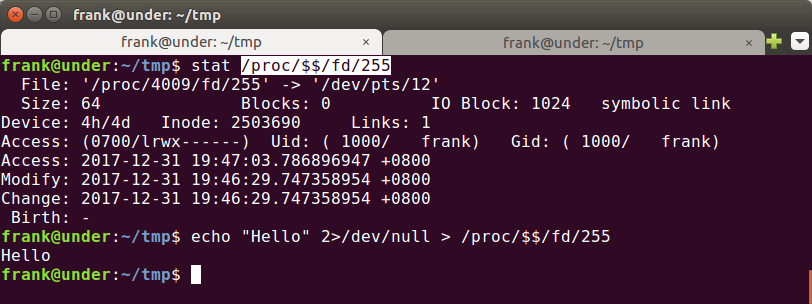
说明Music文件夹下有这三个文件,我也就不需要提前用ls命令来确定了。
但是最近我在查看当前shell(bash)的文件描述符时时却碰见一个“怪事”,当我用bash的自动补全功能查看时,显示为有0, 1, 2, 255, 3这五个文件:

但是当我用ls命令来显示fd文件夹的时候,却只显示有0, 1, 2, 255这4个文件,3这个文件不存在:

这是为什么呢?
其实原因很简单,自动补全功能是bash内置的一个功能,而ls是系统上的一个程序,以子进程的形式独立于bash运行。所以如果bash这个自动补全功能打开了我们要补全的路径(文件夹也是文件),那么应该会获得文件描述符3,ls也是一样。但是5736这个PID是bash的,所以我们用ls的时候看不到3而用bash的自动补全功能看得到。
为了证实一下这个的想法,上网查了一下相关资料,了解到bash自动补全功能本身就是一个用shell语言写的脚本,其配置在/etc/bash_completion这个文件中,其中常用的内置命令是complete ,用法为complete -F _known_hosts xvncviewer ,即当开头的命令./程序是xvncviewer 的时候,如果用户在参数上连按Tab键就会调用_known_hosts这个shell内置函数 ,例如:
skx@lappy:~$ xvncviewer s[TAB]
savannah.gnu.org ssh.tardis.ed.ac.uk
scratchy steve.org.uk
security.debian.org security-master.debian.org
sun
skx@lappy:~$ xvncviewer sc[TAB]
我们进入/etc/bash_completion文件,查找刚刚使用的ls命令,看看它的自动补全是什么配置的:
complete -F _longopt a2ps awk base64 bash bc bison cat colordiff cp csplit
cut date df diff dir du enscript env expand fmt fold gperf
grep grub head indent irb ld ldd less ln ls m4 md5sum mkdir mkfifo mknod
mv netstat nl nm objcopy objdump od paste pr ptx readelf rm rmdir
sed seq sha{,1,224,256,384,512}sum shar sort split strip sum tac tail tee
texindex touch tr uname unexpand uniq units vdir wc who
可以看到,其调用的是_longopt这个内置函数,继续定位:
_longopt()
{
local cur prev words cword split
_init_completion -s || return
case "${prev,,}" in
--help|--usage|--version)
return 0
;;
--*dir*)
_filedir -d
return 0
;;
--*file*|--*path*)
_filedir
return 0
;;
--+([-a-z0-9_]))
local argtype=$( $1 --help 2>&1 | sed -ne
"s|.*$prev[{0,1}=[<[]{0,1}([-A-Za-z0-9_]{1,}).*|1|p" )
case ${argtype,,} in
*dir*)
_filedir -d
return 0
;;
#......省略
可以看到_longopt会调用_filedir这个函数:
_filedir()
{
local i IFS=$'
' xspec
_tilde "$cur" || return 0
local -a toks
local quoted x tmp
_quote_readline_by_ref "$cur" quoted
x=$( compgen -d -- "$quoted" ) &&
while read -r tmp; do
toks+=( "$tmp" )
done <<< "$x"
if [[ "$1" != -d ]]; then
# Munge xspec to contain uppercase version too
# http://thread.gmane.org/gmane.comp.shells.bash.bugs/15294/focus=15306
xspec=${1:+"!*.@($1|${1^^})"}
x=$( compgen -f -X "$xspec" -- $quoted ) &&
while read -r tmp; do
toks+=( "$tmp" )
done <<< "$x"
fi
# If the filter failed to produce anything, try without it if configured to
[[ -n ${COMP_FILEDIR_FALLBACK:-} &&
-n "$1" && "$1" != -d && ${#toks[@]} -lt 1 ]] &&
x=$( compgen -f -- $quoted ) &&
#......省略
可以看到该函数使用了compgen这个内置命令来获取文件夹下的文件名(-f = "filename"),例如:

我们使用strace来追踪这个内置命令的系统调用,特别是返回文件描述符的系统调用open:

通过对比可以看到compgen调用open打开了这个文件夹,而且得到了文件描述符3(前面的open都调用了close删除了它们得到的文件描述符3)。
如果将compgen换成ls :

对比可以看出,compgen只有一个execve ,即compgen是在bash进程中执行的,但ls有两个,第二个说明了它是作为bash的子进程运行的, 证实了我们之前的想法。
如果感兴趣的话可以看看ls的源码,其中使用到了readdir opendir这两个库函数(GNU coreutils-8.29)
综上,我们可以用两个图来总结。
自动补全:
Process: Bash
+-----------------------------+
| |
| 0,1,2,255 0,1,2,3,255|
| Tab->compgen->open |
| |
+-----------------------------+
ls 命令:
Process: Bash
+-----------------------------+
| |
| 0,1,2,255 |
| ls |
| + |
+-----------------------------+
|
|
| Child Process: ls
+------+----------------------+
| |
|0,1,2 0,1,2,3 |
| opendir->open |
+-----------------------------+
另外,如果我们将操作应用于 /proc/self/文件夹也会得到一些有意思的结果:

第一行我们已经讲明白了,但是第二行和第三行怎么解释呢?
在man 5 proc下对这个文件夹的解释是这样的:
/proc/self
This directory refers to the process accessing the /proc
filesystem, and is identical to the /proc directory named by the
process ID of the same process.
也就是说, /proc/self/反应的是当前访问文件的进程的状态数据 ,所以我们用ls /proc/self/fd/实际上是ls /proc/${PID of ls}/fd/ ,而ls会打开这个文件夹(同时获得3这个文件描述符),所以就会看到0,1,2,3这个四个文件了。但如果我们直接ls /proc/self/fd/3 ,这个时候ls的进程还没有获得3这个描述符,就尝试去打开3这个不存在的文件,所以就报错了。在CentOS的文档中提到了这个文件夹的作用:
The /proc/self/ directory is a link to the currently running process. This allows a process to look at itself without having to know its process ID.
另外提一下bash进程中的255文件描述符,这个是bash独有的一个小“trick”,其对应的文件是一个终端设备:

这次碰到的问题抽象点说就是获取信息的手段本身会影响信息,这样的问题在很多地方都有体现,简单的例如用ps aux | wc通过行数来获取进程数,但ps aux本身在运行的时候就会形成一个进程,以后需要注意;)
参考: